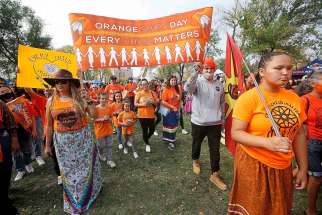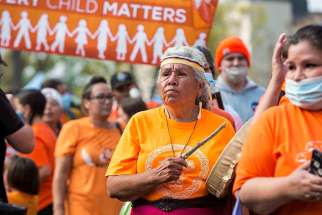‘Such a beautiful day’: Manitobans take to streets in name of truth, reconciliation
Read this article for free:
or
Already have an account? Log in here »
To continue reading, please subscribe:
Monthly Digital Subscription
$0 for the first 4 weeks*
- Enjoy unlimited reading on winnipegfreepress.com
- Read the E-Edition, our digital replica newspaper
- Access News Break, our award-winning app
- Play interactive puzzles
*No charge for 4 weeks then price increases to the regular rate of $19.00 plus GST every four weeks. Offer available to new and qualified returning subscribers only. Cancel any time.
Monthly Digital Subscription
$4.75/week*
- Enjoy unlimited reading on winnipegfreepress.com
- Read the E-Edition, our digital replica newspaper
- Access News Break, our award-winning app
- Play interactive puzzles
*Billed as $19 plus GST every four weeks. Cancel any time.
To continue reading, please subscribe:
Add Free Press access to your Brandon Sun subscription for only an additional
$1 for the first 4 weeks*
*Your next subscription payment will increase by $1.00 and you will be charged $16.99 plus GST for four weeks. After four weeks, your payment will increase to $23.99 plus GST every four weeks.
Read unlimited articles for free today:
or
Already have an account? Log in here »
Hey there, time traveller!
This article was published 30/09/2021 (1530 days ago), so information in it may no longer be current.
A sea of orange flooded downtown Winnipeg, as thousands of Manitobans came together to honour residential school survivors, mourn those lost to the system, and mark the first National Day for Truth and Reconciliation.
On Thursday morning, outside the towering Canadian Museum for Human Rights, a historic sight: crowds of people in orange shirts honouring a group of Sixties Scoop, residential school and day school survivors gathered on the steps.
“We went there as beautiful children; we wake up every day with these memories,” Gerry Shingoose — herself a residential school survivor — called into a megaphone, looking out at the growing crowd.

“Today is such a beautiful day to honour each one of us.”
Shingoose offered a prayer, kicking off a healing walk that would lead thousands of people from the museum steps to Main Street, and northward to a powwow at St. John’s Park.
“We really wanted to honour those who have made it home and also the children that did not make it home,” said Katherine Legrange, director of the Sixties Scoop Legacy of Canada, who organized the walk.
“This year was especially important as the discoveries keep happening of children found in unmarked graves at residential facilities, and because this is the first official National Day of Truth and Reconciliation. So we thought it was really important to hold something where everybody could participate.”
As the crowd marched its way through the downtown, cries of “Every child matters” rose above the din of cheering, honking horns, drumming and singing.
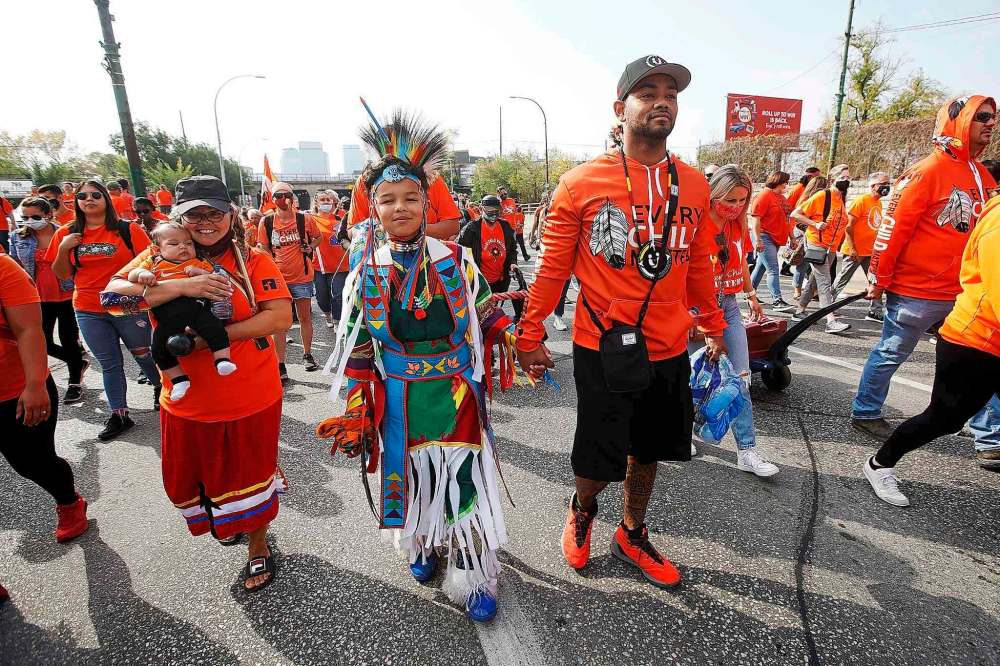
“We see you. We hear you. We believe you. We love you,” the crowd called, echoing Shingoose’s words on the megaphone.
At the front, the Spirit Sands Singers led with songs, joined by a group of community leaders and youth. Among them were Tracy Mentuck and her seven-year-old son Teatum: a young dancer who was asked to guide Thursday’s march.
“I’m honoured to be here and honoured for my son to lead this walk,” said Mentuck. “Little voices like this need to be heard. These are our generations right here, and they’re going to carry on with our traditions.”
Teatum, for his part, expressed excitement and joy to be part of the event.
Winnipeg police and event organizers estimate more than 10,000 people joined the walk, and more than 12,000 attended the powwow at St. John’s Park. At some points, the crowd stretched from Shaw Park to the Disraeli Freeway.
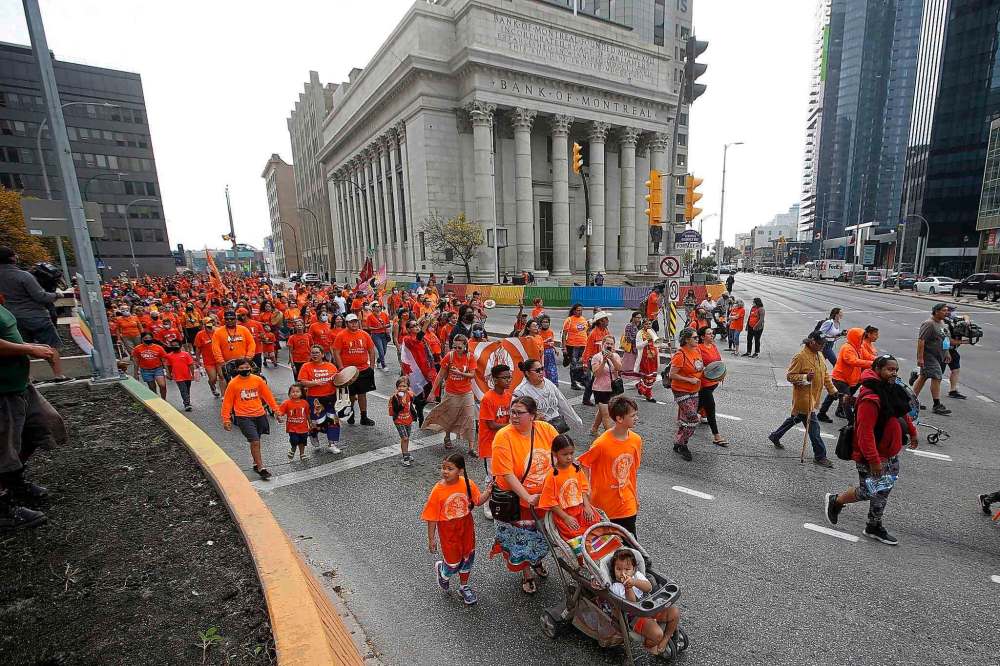
Isabelle Lewis joined in support of survivors, in memory of her father, and to grieve the children removed at young ages from their homes by the Canadian government.
After the news in May of more than 200 potential unmarked graves found near a former residential school in Kamloops, B.C., Lewis began walking in Winnipeg each day. The effort was to honour the lost children, and to begin healing the trauma she carries through her father, who attended a residential school.
“I now learned why I grew up with so much hurt and unspoken words. I’m not going to be quiet no more, I’m going to give it a voice.”
At least once a week she would walk 10 kilometres, other days slightly less. She was forced to stop when she fractured her heel, but took to the streets again Thursday in a boot cast.
“I walked, I walked; I cried, I cried,” said Lewis. “I thought of my pain, my dad’s pain, my dad’s unspoken words — and I still feel it as I walk today.”
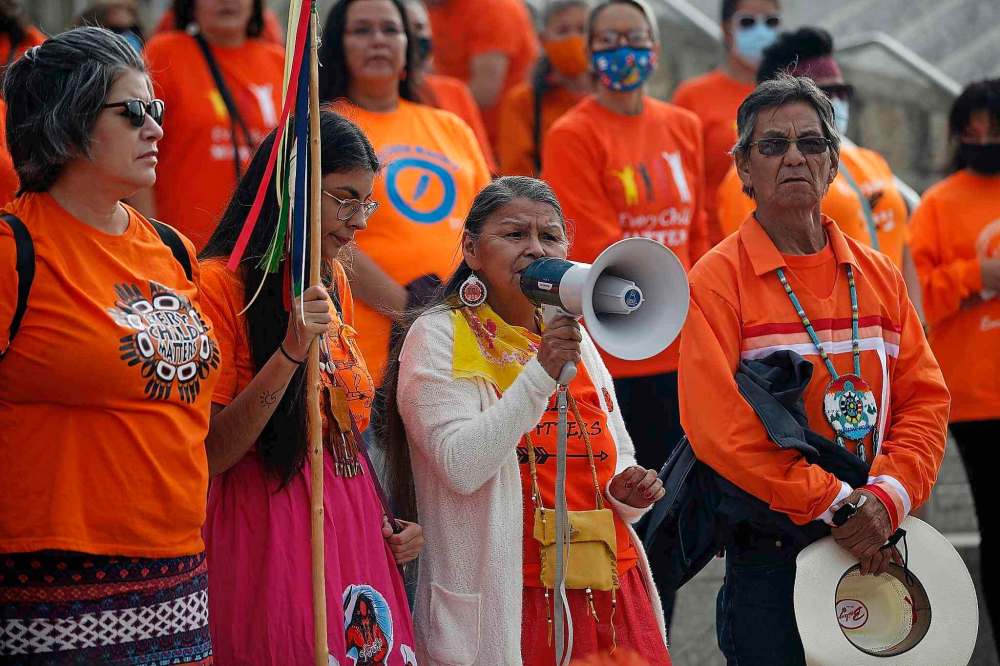
As the march drew to a close, the crowd merged with more than 1,000 people already gathered at St. John’s Park for a powwow.
“I’ve got lots of pride, because all these people supporting not only us but the ones who have passed on before, it’s quite the turnout,” said Sixties Scoop survivor Waylon Flett.
“There’s thousands of people out here today, so hopefully this raises some awareness. This intergenerational trauma has to stop somewhere.”
At a morning gathering on King Street, Emily Stefanyshyn, 15, spontaneously took the podium at Ma Mawi Wi Chi Itata Centre’s Every Child Matters event.
Her young relatives joined her. They said they were thankful to those in attendance, as families gathered in prayer and reflection, honouring children who’d attended residential schools.
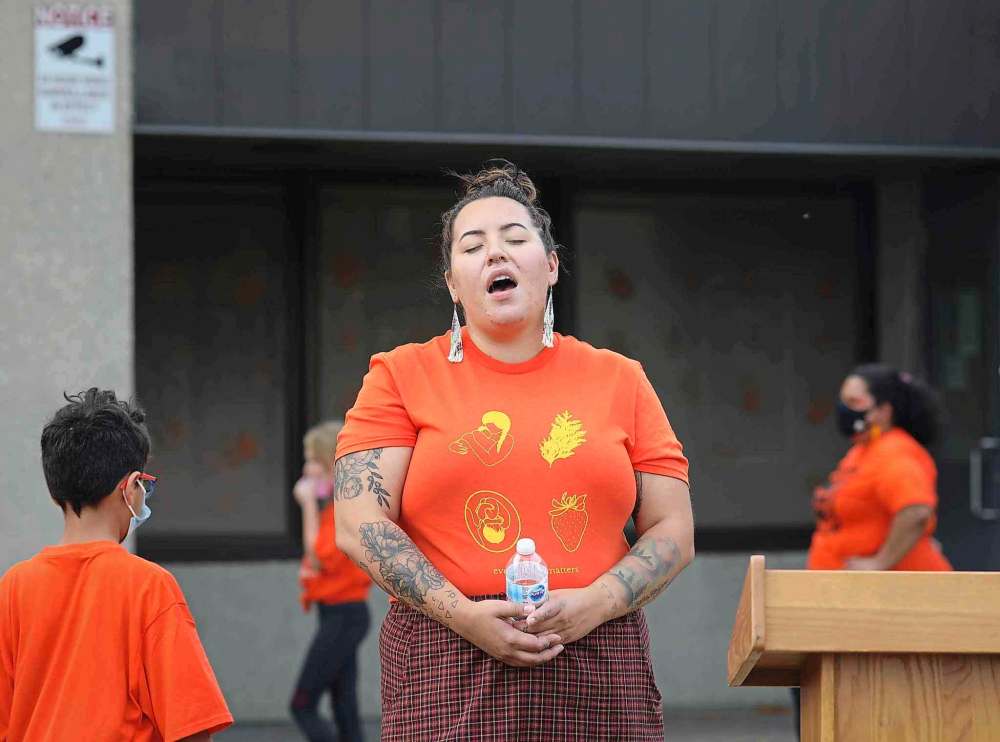
“(I’m) trying to educate all of my peers who don’t know about it,” the blue-haired teen said later.
Emily has one eye on the past and another on the future. She’s part of Ma Mawi’s youth truth and reconciliation program, and has spent six months creating a module on Indigenous history and culture. Residential schools and missing and murdered Indigenous women and girls are key topics.
“It’s important to honour people that went through a lot,” she said. “I hope to get our module… into the school system.”
“This whole event, we really centred it around youth, because we know youth are the next generation and they’re the ones who are going to be sharing these stories and messages,” said Katie McKenzie, the event’s supporting co-ordinator. “If they can do this… then we are going to continue moving forward in truth and reconciliation.”
McKenzie, 20, plans to focus her future employment law career on reconciliation.
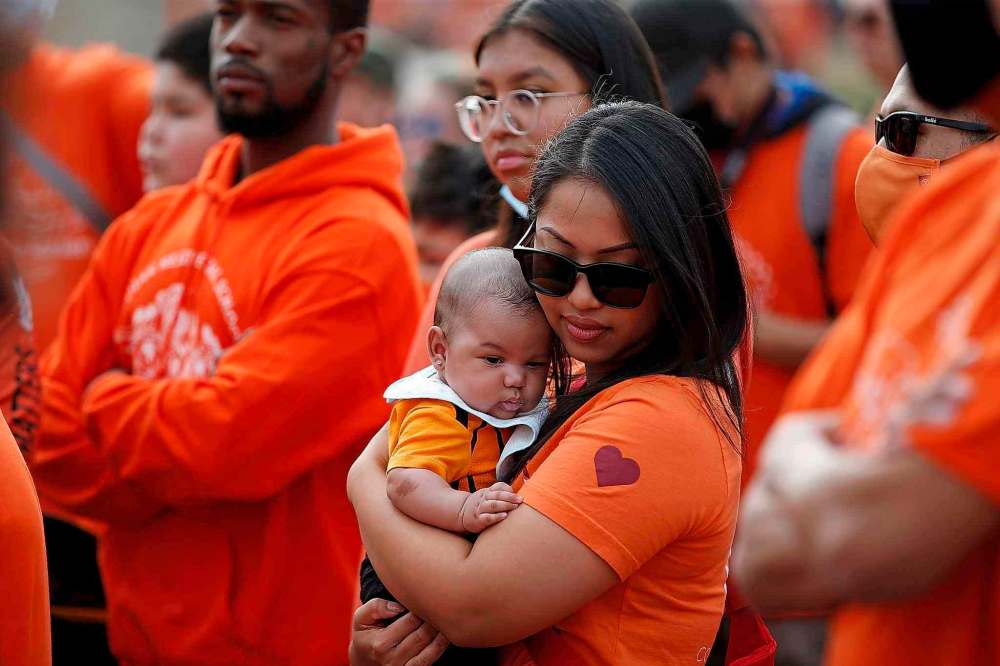
“I really feel that systematically there’s a lot of work that can be done between Indigenous and non-Indigenous people in the workplace.”
Seth Poirier, 18, accepted an offer for smudging at Thursday’s event. His great-grandmother went to residential school; she doesn’t talk about it, but he knows the history. He wants to be a social worker.
“I want to bring people up,” he said.
Courtney Kszywiecki wore an orange sweater, ribbon skirt and moccasins to Ma Mawi. Her Swampy Cree grandparents stopped practicing their culture, she said. She attended Thursday for them.
“They stopped, and they just brushed it aside and acted like it wasn’t their identity because they were so afraid of going to the residential schools,” the 26-year-old said.
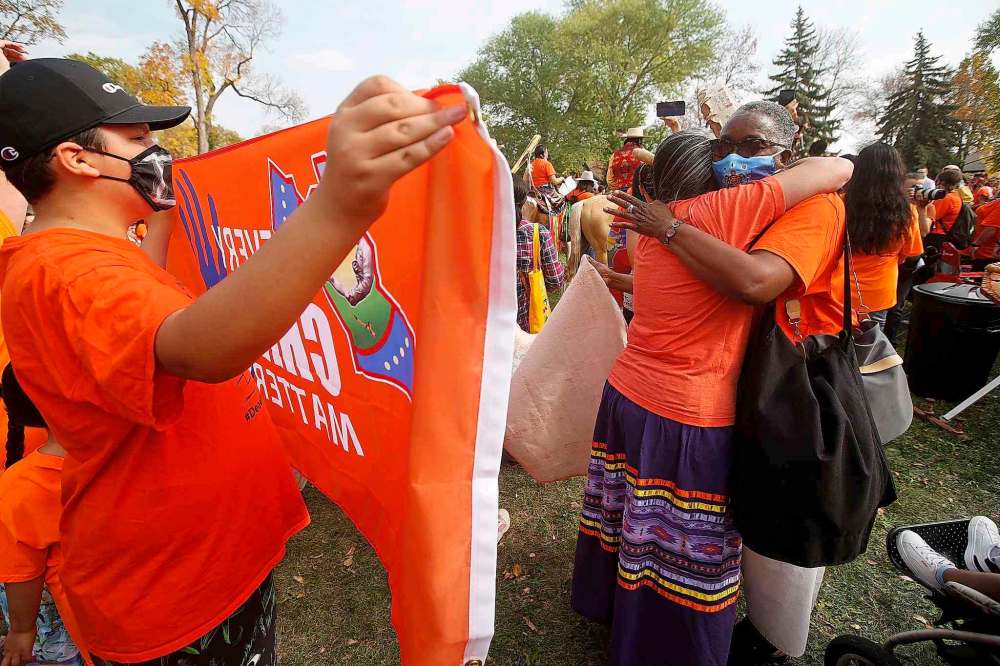
Kszywiecki called the new national day “a step in the right direction”.
“I also think that people need to realize that it’s not a day off,” she said. “It’s a day for reflection.”
julia-simone.rutgers@freepress.mb.ca
Twitter: @jsrutgers
gabrielle.piche@freepress.mb.ca

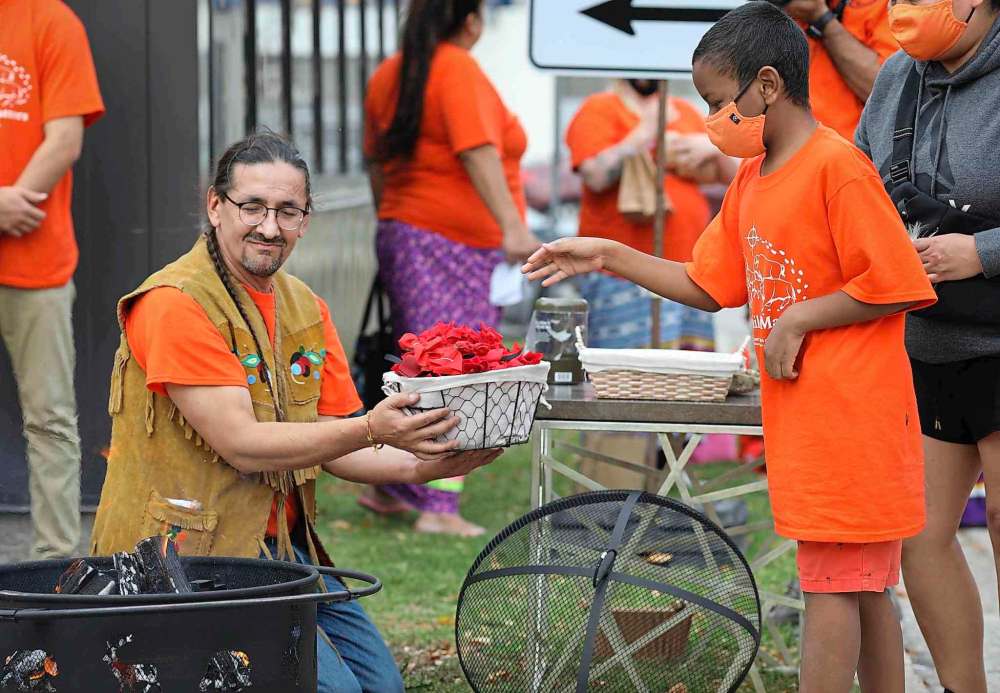

A day to reflect
Commemorations across Winnipeg began as dawn broke Thursday, with a ceremony at The Forks, a historical gathering place for Indigenous people.
“The sunrise ceremony represents a big step in downtown Winnipeg, doing something we would have been arrested for only a few decades ago,” said Free Press columnist Niigaan Sinclair, Indigenous curator of The Forks National Historical Site.
“Today is a day to reflect on a history full of violence but also commit ourselves to real actions embedded in change and building a community better than we inherited.”
Elsewhere in the city, the Winnipeg Art Gallery hosted residential school survivors to share their stories with the public.
Later in the morning, survivors, leaders and youth from Fox Lake and York Factory First Nations and Tataskweyak Cree Nation marched to the Manitoba legislature from the airport area, completing a 1,000-kilometre unity walk from Gillam that began Sept. 18.
The trek, intended to honour residential school survivors, also worked to bring awareness to the needs of northern First Nations that endure the intergenerational effects of the system without the same supports available in southern Manitoba.

Julia-Simone Rutgers is a climate reporter with a focus on environmental issues in Manitoba. Her position is part of a three-year partnership between the Winnipeg Free Press and The Narwhal, funded by the Winnipeg Foundation.

Gabby is a big fan of people, writing and learning. She graduated from Red River College’s Creative Communications program in the spring of 2020.
Our newsroom depends on a growing audience of readers to power our journalism. If you are not a paid reader, please consider becoming a subscriber.
Our newsroom depends on its audience of readers to power our journalism. Thank you for your support.
History
Updated on Thursday, September 30, 2021 11:04 PM CDT: Adds missing word 'of' to sentence








